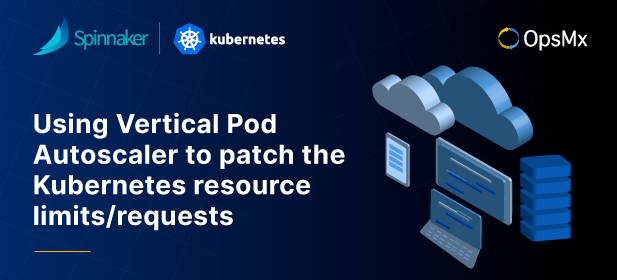Problem Introduction:
In Part 1, We have seen how to automate the process of increasing the limits/requests for the pods memory/cpu using the webhook alerts feature of alert manager and webhook triggered pipelines of spinnaker.
But what value should we patch? How to decide on the optimal values for cpu/memory as these values varies from application to application, we are going to address the same in the below solution.
Solution Introduction:
Vertical Pod Autoscaling provides recommendations for resource usage over time. We can configure vertical Pod Autoscaling to provide recommended values for CPU and memory requests and limits that we can use to manually update/patch for the Pods.
Prerequisites:
Spinnaker installed, prometheus and alertmanager installed to monitor pods in the cluster, VPA enabled with updatePolicy.updateMode set to 'Off'.
Details:
For Part 1, we have used a manifest file from the example present in the following link
https://kubernetes.io/docs/tasks/configure-pod-container/assign-memory-resource/
We have converted the above manifest file into a deployment and now we are going to deploy a Vertical Pod Autoscaler (VPA) as well along with it.
apiVersion: apps/v1
kind: Deployment
metadata:
labels:
app: mem-high
for: feedback
name: mem-too-high
spec:
replicas: 1
selector:
matchLabels:
app: mem-high
template:
metadata:
labels:
app: mem-high
spec:
containers:
- args:
- '--vm'
- '1'
- '--vm-bytes'
- 150M
- '--vm-hang'
- '1'
command:
- stress
image: polinux/stress
name: mem-high
resources:
limits:
memory: 165Mi
requests:
memory: 100Mi
apiVersion: autoscaling.k8s.io/v1
kind: VerticalPodAutoscaler
metadata:
name: mem-too-high
spec:
targetRef:
apiVersion: extensions/v1beta1
kind: Deployment
name: mem-too-high
updatePolicy:
updateMode: 'Off'
As you can see the above Deployment file creates a pod which continuously uses 150M of memory. Which is more than 90% of 165Mi of limits that was configured. Once this crosses the threshold, we have seen in Part 1 how a webhook alert is triggered by prometheus alert-manager and how it triggers the pipeline and patches the deployment file.
But what value to patch? For that before the patch stage we are going to check for the VPA recommendations and get the memory/cpu recommended value using Spinnaker SpEL Expressions and pass on the value to the patch stage. Please note that these recommendations provided by VPA will be applicable to this specific deployment. Also we will be running VPA in offline mode, this means we are using VPA only for recommendations but not allowing it to go and do the modifications by itself.
This is how the VPA object looks like, under status.recommendation we can see the values VPA came up for this deployment.
kubectl get vpa mem-too-high -n default -o yaml
apiVersion: autoscaling.k8s.io/v1
kind: VerticalPodAutoscaler
metadata:
annotations:
artifact.spinnaker.io/location: default
artifact.spinnaker.io/name: mem-too-high
artifact.spinnaker.io/type: kubernetes/VerticalPodAutoscaler.autoscaling.k8s.io
artifact.spinnaker.io/version: ""
kubectl.kubernetes.io/last-applied-configuration: |
{"apiVersion":"autoscaling.k8s.io/v1","kind":"VerticalPodAutoscaler","metadata":{"annotations":{"artifact.spinnaker.io/location":"default","artifact.spinnaker.io/name":"mem-too-high","artifact.spinnaker.io/type":"kubernetes/VerticalPodAutoscaler.autoscaling.k8s.io","artifact.spinnaker.io/version":"","moniker.spinnaker.io/application":"feedback","moniker.spinnaker.io/cluster":"VerticalPodAutoscaler.autoscaling.k8s.io mem-too-high"},"labels":{"app.kubernetes.io/managed-by":"spinnaker","app.kubernetes.io/name":"feedback"},"name":"mem-too-high","namespace":"default"},"spec":{"targetRef":{"apiVersion":"extensions/v1beta1","kind":"Deployment","name":"mem-too-high"},"updatePolicy":{"updateMode":"Off"}}}
moniker.spinnaker.io/application: feedback
moniker.spinnaker.io/cluster: VerticalPodAutoscaler.autoscaling.k8s.io mem-too-high
creationTimestamp: "2022-06-23T07:05:32Z"
generation: 886
labels:
app.kubernetes.io/managed-by: spinnaker
app.kubernetes.io/name: feedback
name: mem-too-high
namespace: default
resourceVersion: "63129475"
uid: 739278df-9bb7-490f-b54e-d04108e68f7e
spec:
targetRef:
apiVersion: extensions/v1beta1
kind: Deployment
name: mem-too-high
updatePolicy:
updateMode: "Off"
status:
conditions:
- lastTransitionTime: "2022-06-27T12:32:29Z"
message: Some containers have a small number of samples
reason: mem-high
status: "True"
type: LowConfidence
- lastTransitionTime: "2022-06-27T12:32:29Z"
status: "True"
type: RecommendationProvided
recommendation:
containerRecommendations:
- containerName: mem-high
lowerBound:
cpu: 70m
memory: "119537664"
target:
cpu: 125m
memory: "183500800"
uncappedTarget:
cpu: 125m
memory: "183500800"
upperBound:
cpu: 30210m
memory: "44207964160"
We have taken the recommendation.target value to patch for the deployment file. Once the patching is done we can see that the previous memory limit 165Mi has changed to a value which was recommended by VPA.
spec:
progressDeadlineSeconds: 600
replicas: 1
revisionHistoryLimit: 10
selector:
matchLabels:
app: mem-high
strategy:
rollingUpdate:
maxSurge: 25%
maxUnavailable: 25%
type: RollingUpdate
template:
metadata:
annotations:
artifact.spinnaker.io/location: default
artifact.spinnaker.io/name: mem-too-high
artifact.spinnaker.io/type: kubernetes/deployment
artifact.spinnaker.io/version: ""
moniker.spinnaker.io/application: feedback
moniker.spinnaker.io/cluster: deployment mem-too-high
creationTimestamp: null
labels:
app: mem-high
app.kubernetes.io/managed-by: spinnaker
app.kubernetes.io/name: feedback
spec:
containers:
- args:
- --vm
- "1"
- --vm-bytes
- 150M
- --vm-hang
- "1"
command:
- stress
image: polinux/stress
imagePullPolicy: Always
name: mem-high
resources:
limits:
memory: "183500800"
requests:
memory: 100Mi
terminationMessagePath: /dev/termination-log
terminationMessagePolicy: File
dnsPolicy: ClusterFirst
restartPolicy: Always
schedulerName: default-scheduler
securityContext: {}
terminationGracePeriodSeconds: 30
Due to Kubernetes limitations using VPA the only way to modify the resource requests of a running Pod is to recreate the Pod. If you create a VerticalPodAutoscaler object with an updateMode of Auto, the VerticalPodAutoscaler evicts a Pod if it needs to change the Pod’s resource requests.
https://cloud.google.com/kubernetes-engine/docs/concepts/verticalpodautoscaler
Conclusion:
If a pod gets Evicted, there will be a service disruption before a new pod scales up. Using this method we are patching the pod before the pods goes into eviction state making sure the application is available at all the times.
Acknowledgements:
I thank Gopal Jayanthi Vithal and Srinivas Kambhampati for their inputs.

0 Comments